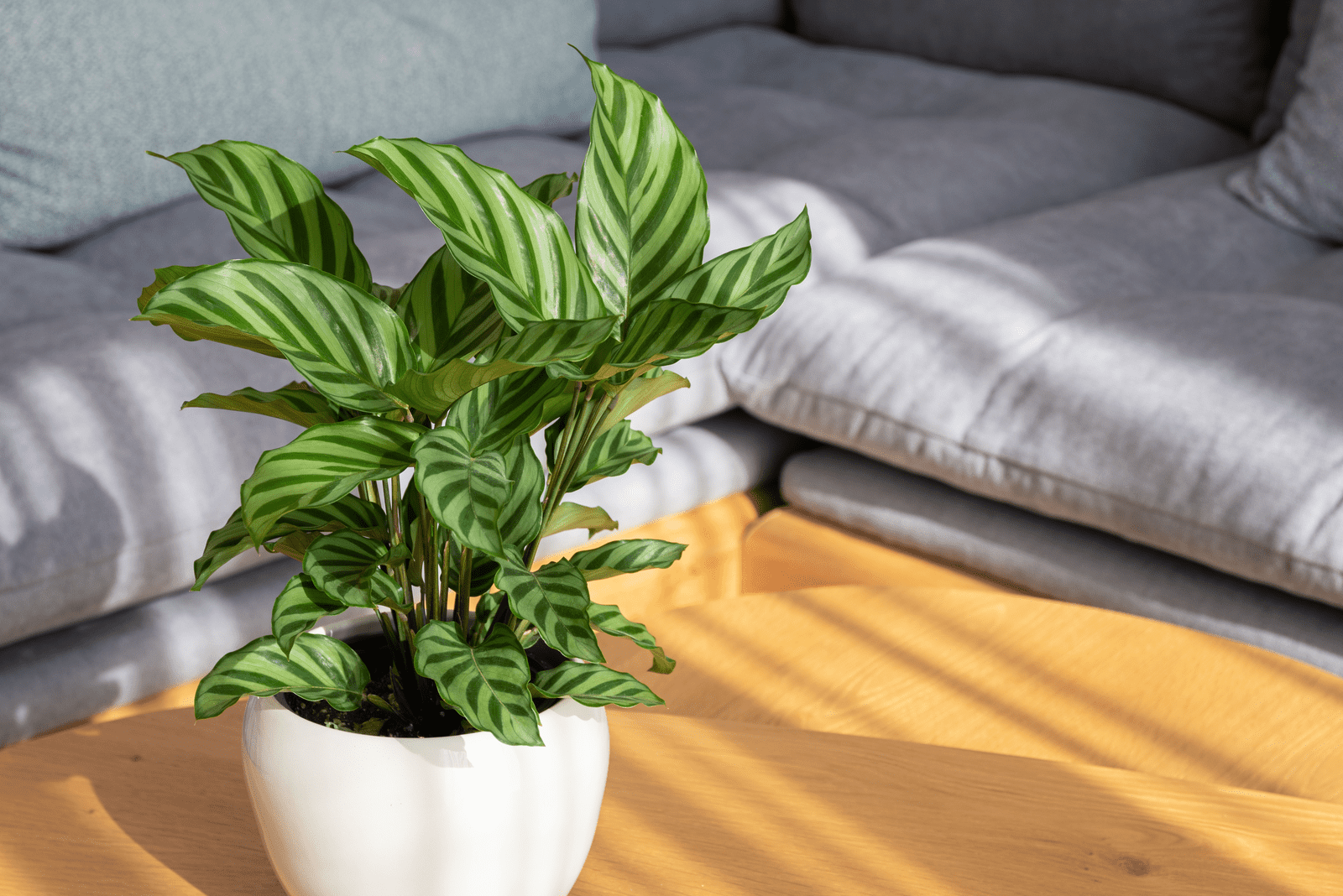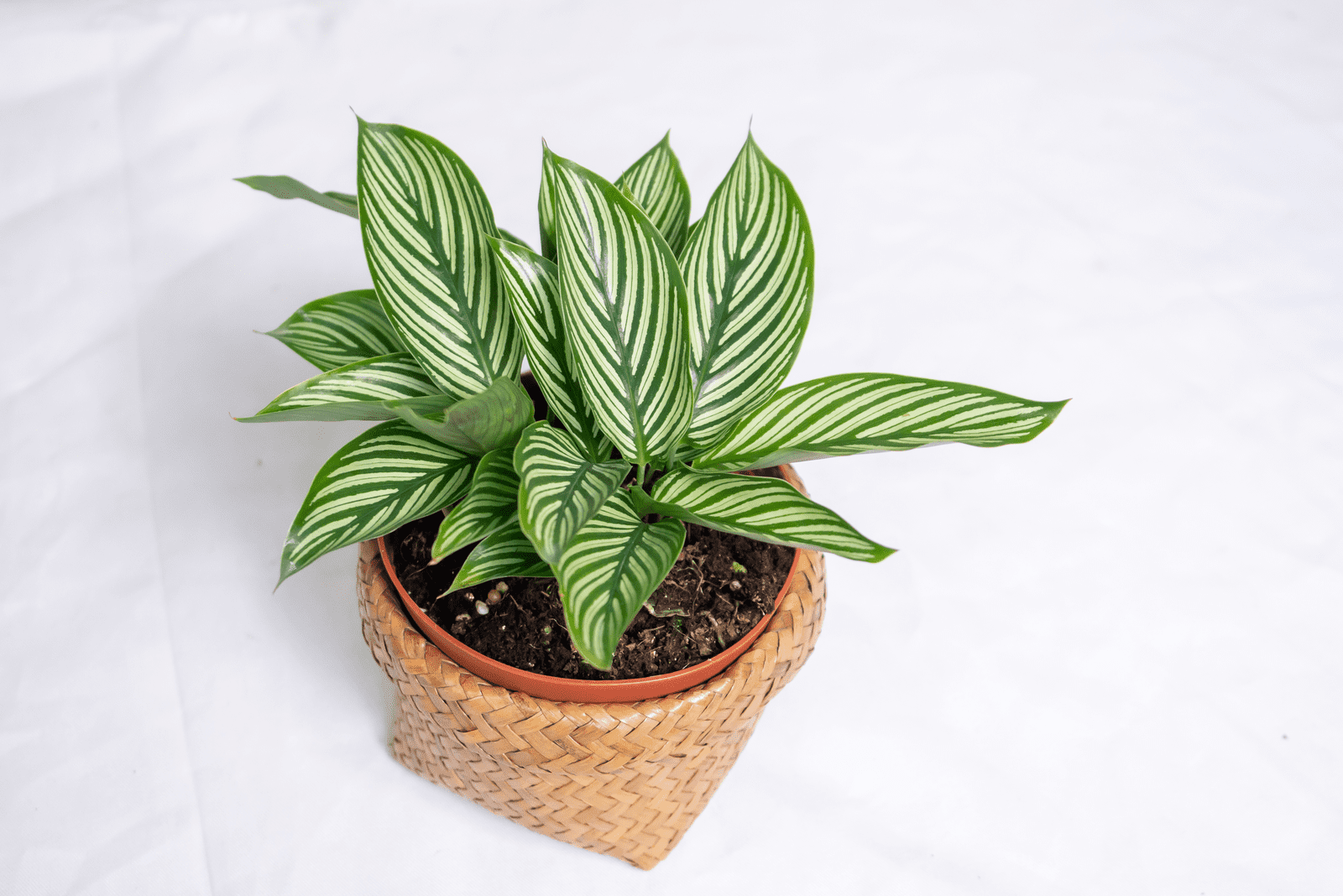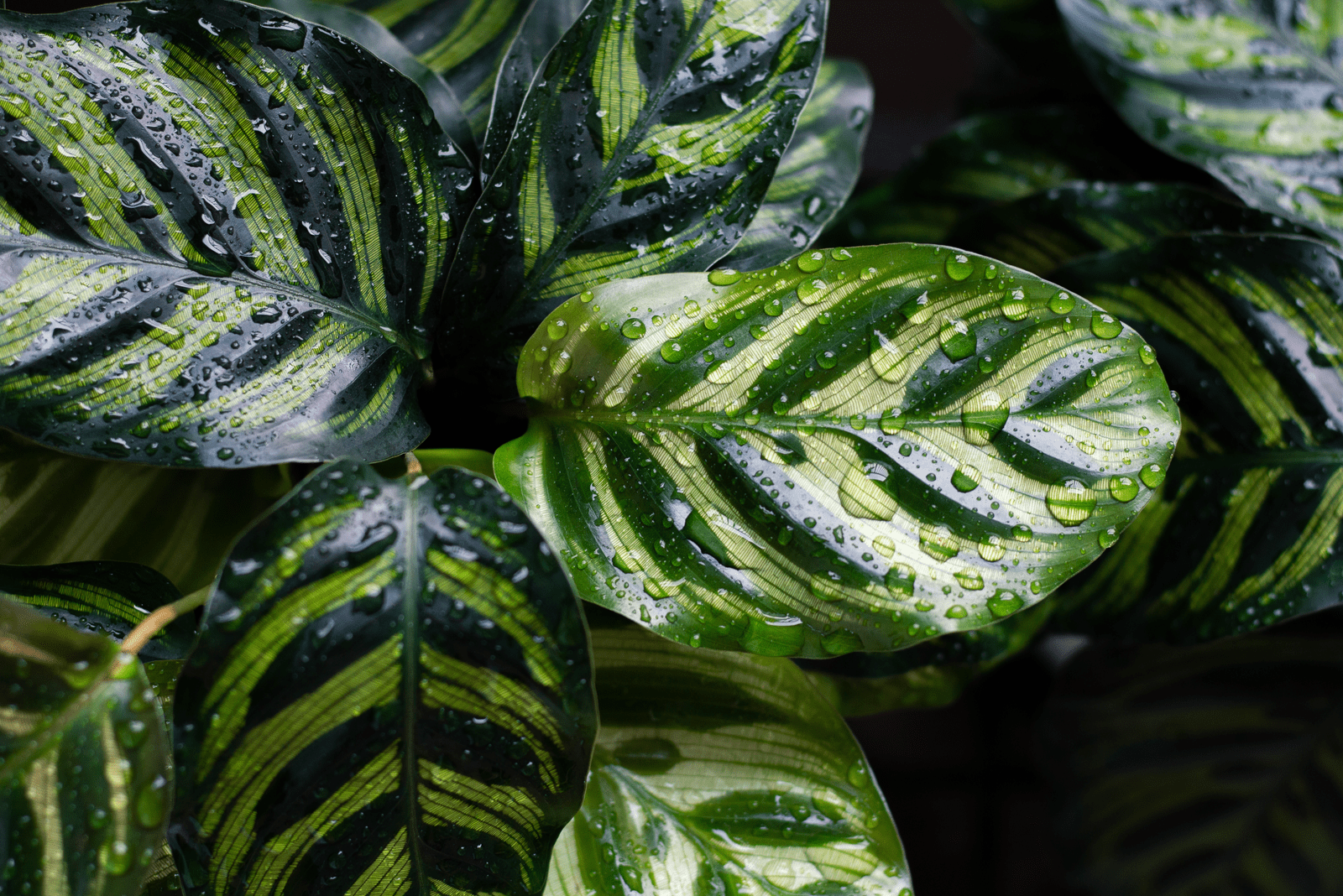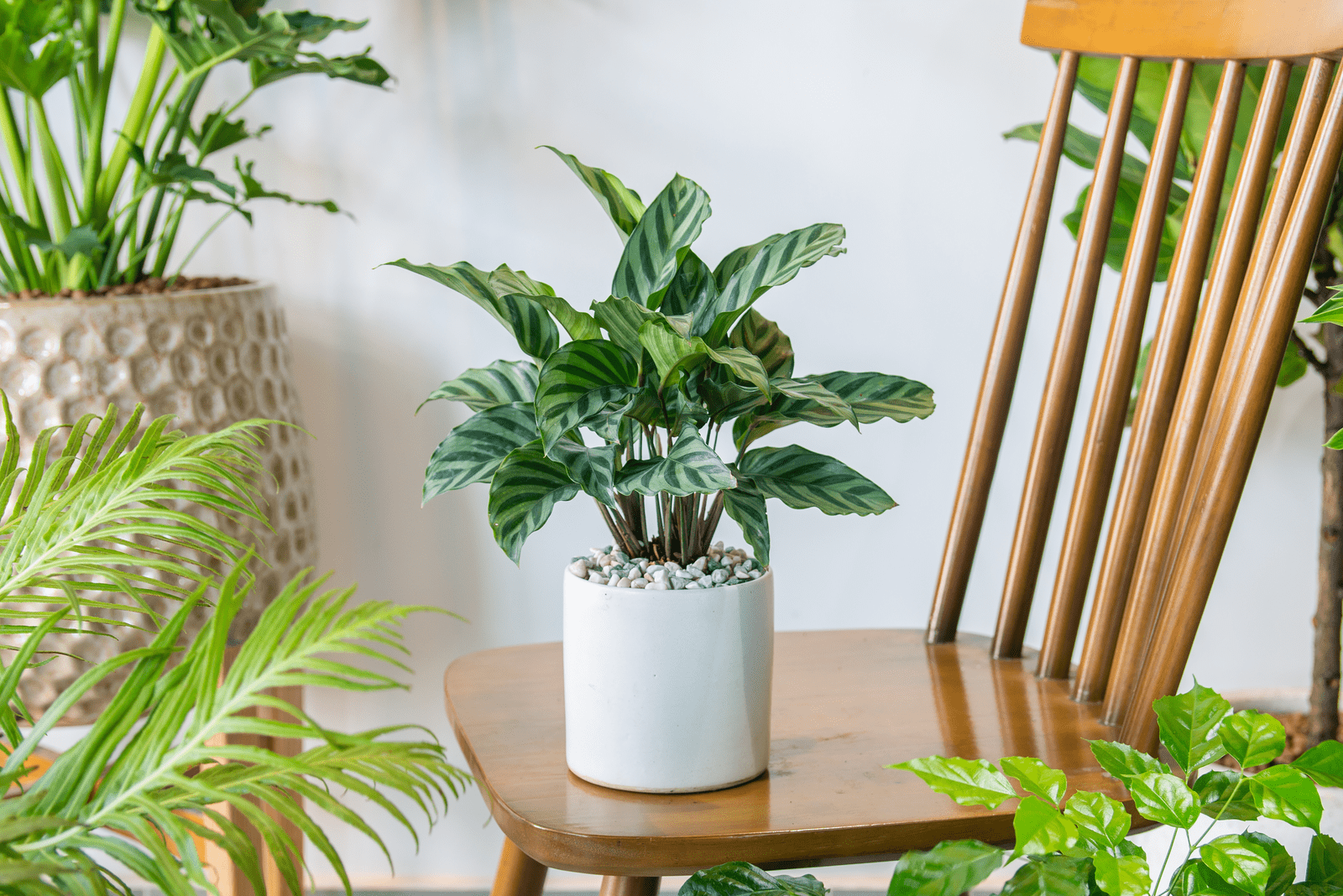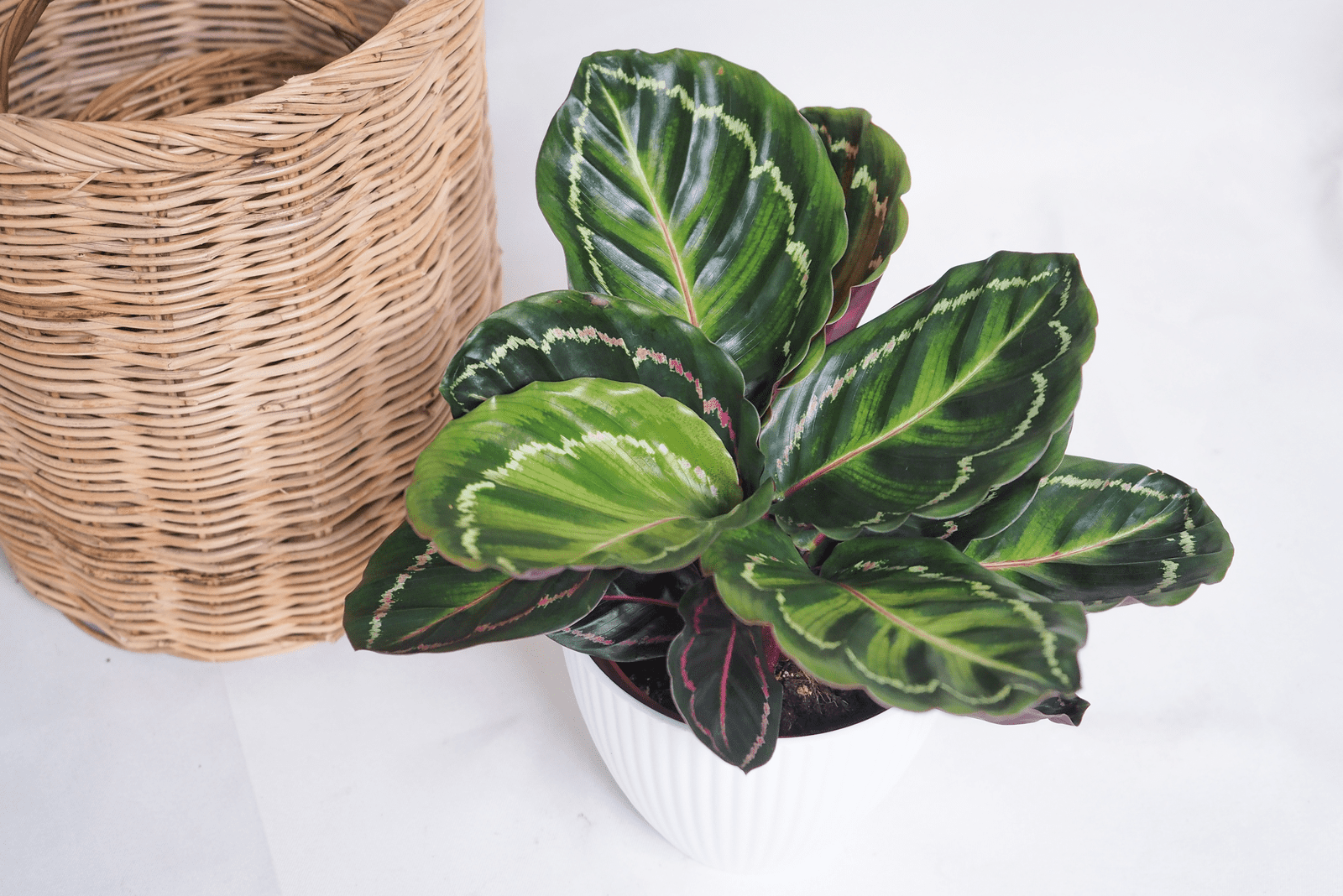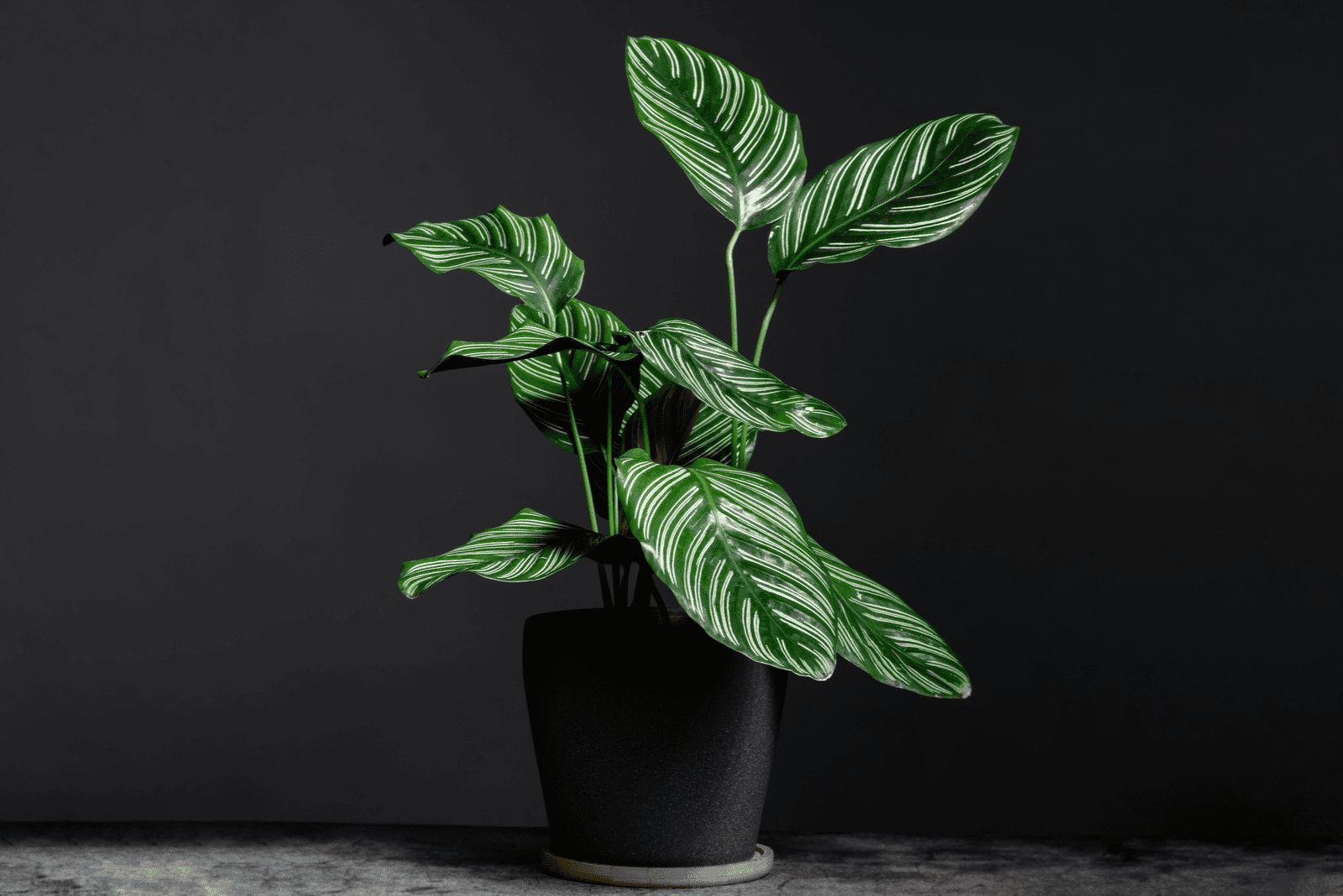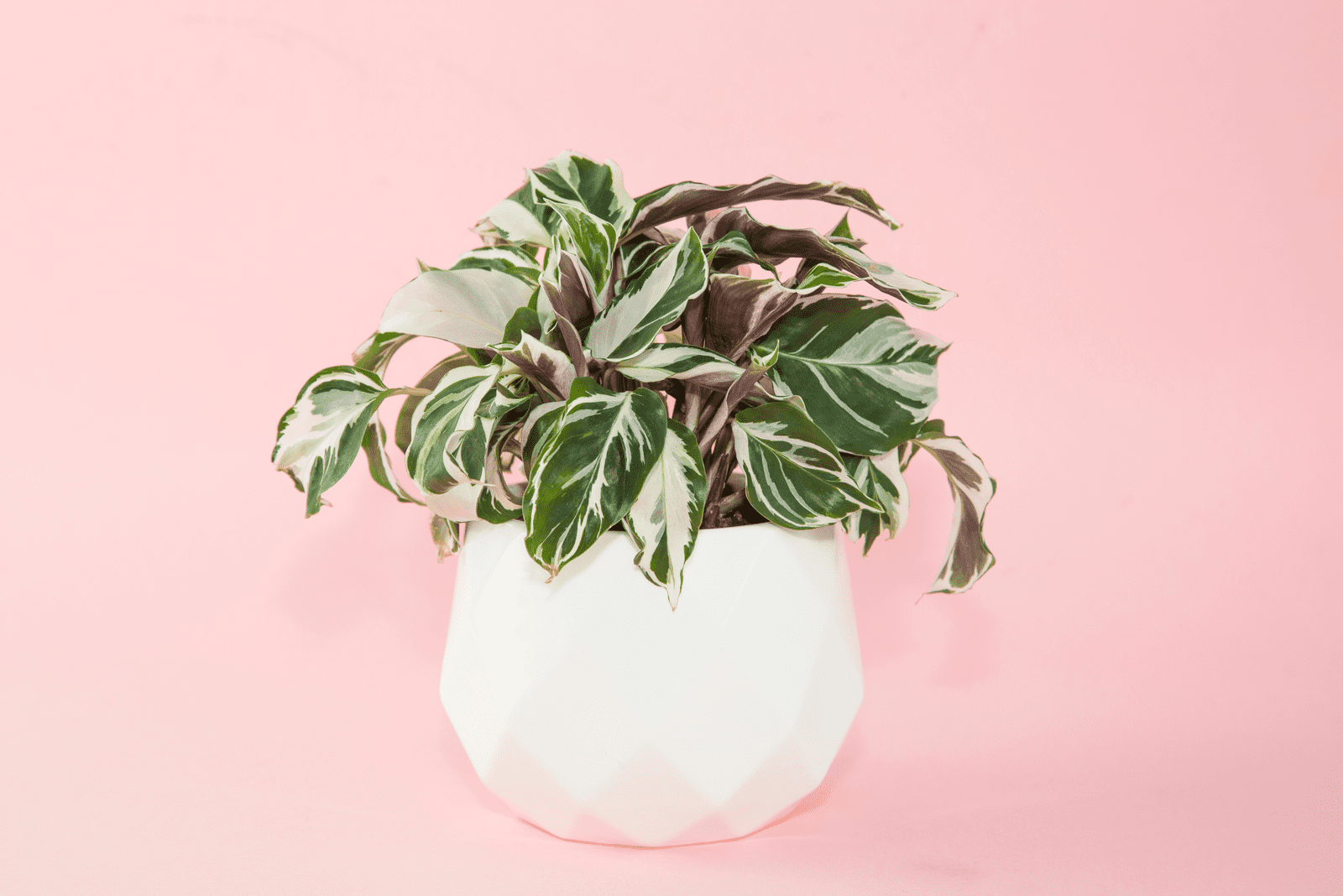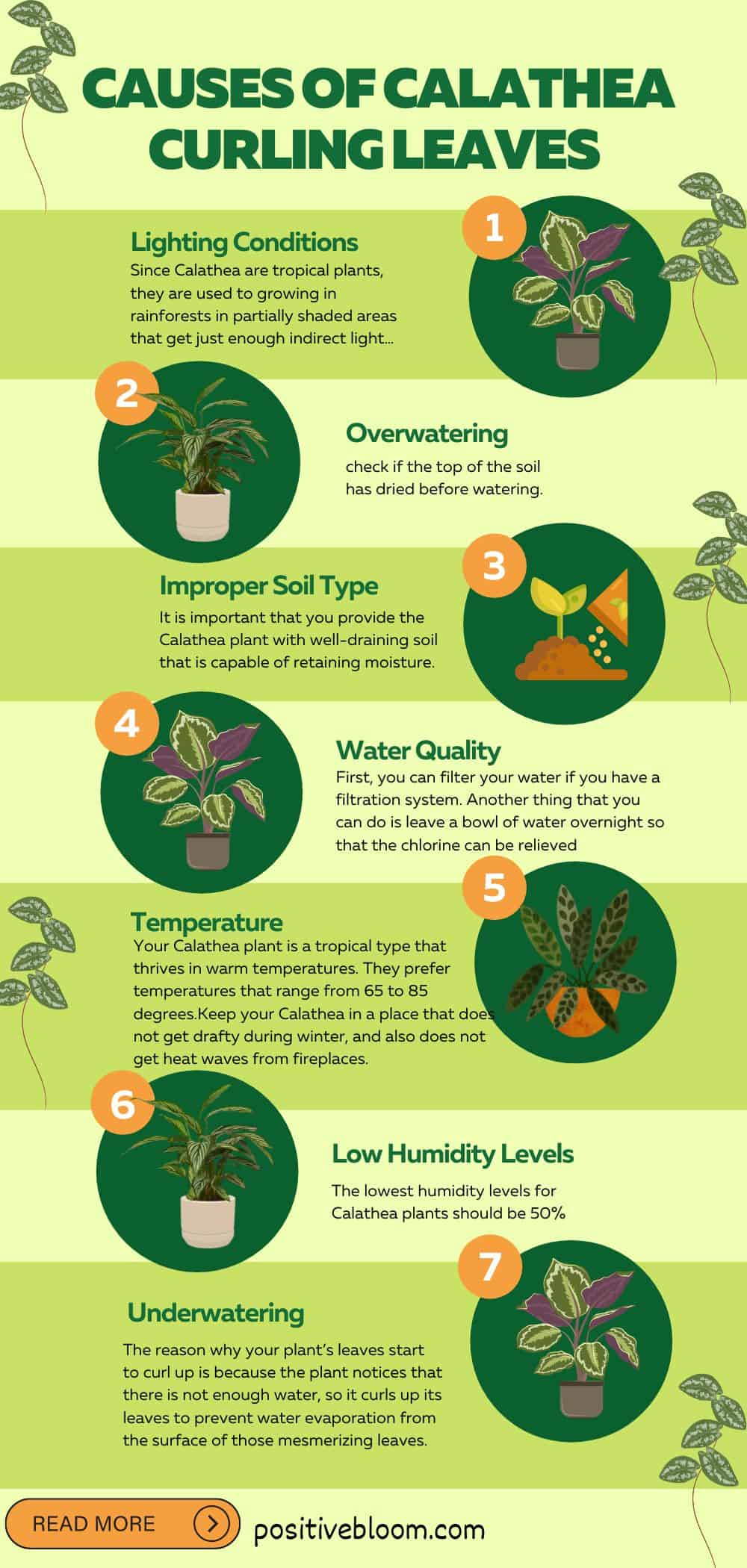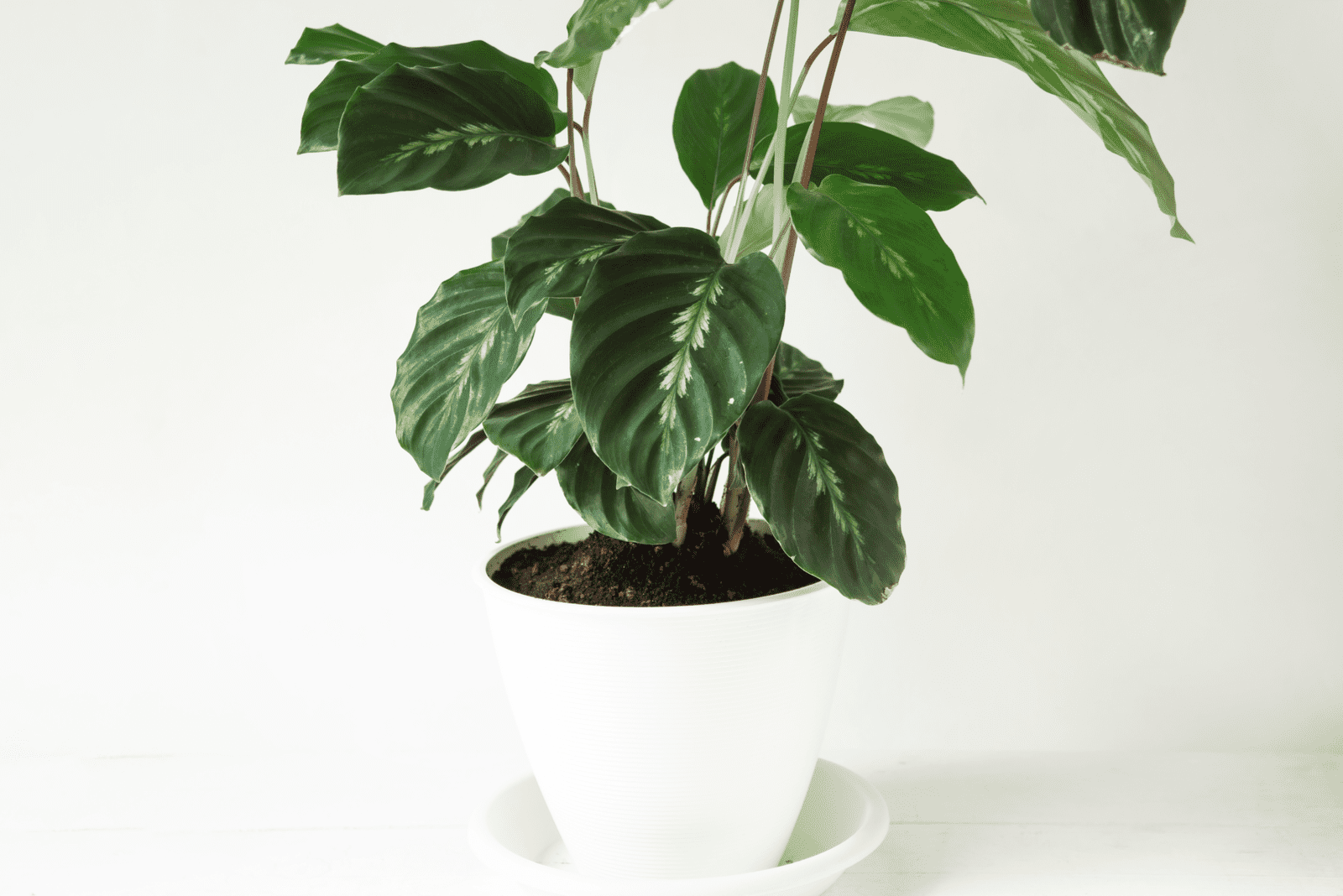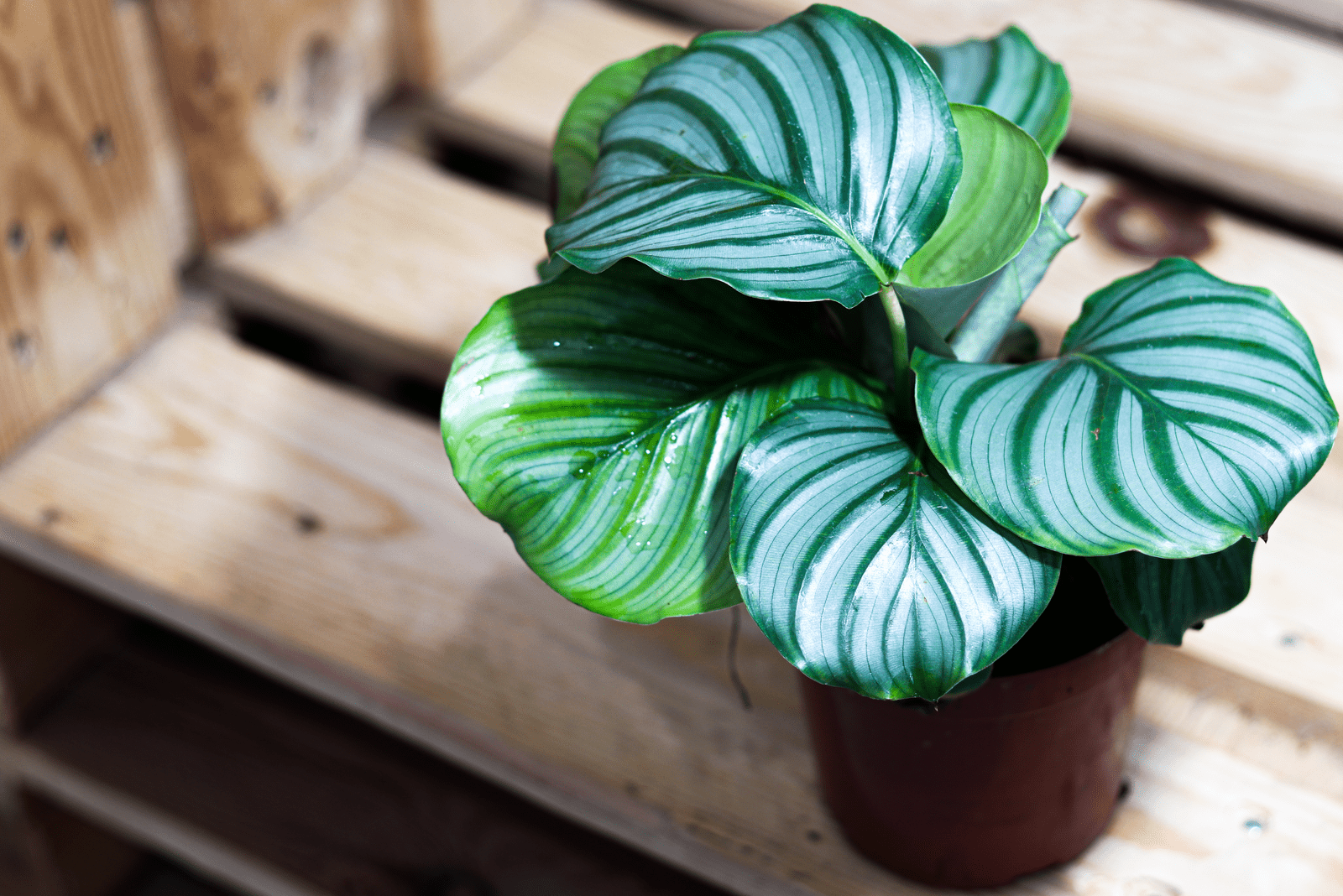The Calathea has become quite a popular houseplant, mainly because it produces leaves that have glossy, compact, dark and light green stripes, with a contrasting purple shade on the underside.
The leaves are unusual due to the patterns they have, as well as the eye-catching veins that protrude from the leaves’ surfaces, making them truly intriguing… so, what to do when these beauties start to curl and change color?
Calathea curling leaves is a common issue with these types of plants — it is because they require special watering treatment; and, if you slightly overwater or underwater your Calathea plant, it will bother your plant.
Asides from that, temperatures and humidity levels can also affect the moisture levels, as well as the type and quality of the soil.
But, don’t you worry, all of these issues can be easily fixed!
So, if you have noticed that your Calathea has curling leaves, read on and find out the reasons why this is happening, and also the solutions to your problem!
The Causes Of Calathea Curling Leaves
First, we are going to talk about the reasons why your Calathea leaves are curling and changing, and what the possible solutions to these issues are.
Take a look below to see the cause of Calathea curling leaves:
• too much light provided;
• frequent watering;
• improper soil;
• water quality;
• temperature;
• humidity;
• underwatering;
• pests and diseases;
• overfertilization.
Let’s go, one by one, and see how you can deal with each of these issues.
1. Improper Lighting Conditions: Too Much Light Exposure
Since Calathea are tropical plants, they are used to growing in rainforests in partially shaded areas that get just enough indirect light… so, can you imagine the shock that your plant experiences when it is overly exposed to direct sunlight?
Just like your skin would burn during summer, a similar thing happens to your plant — the edges of the leaves start turning brown, and your plants definitely don’t want to look tanned!
Not only that, but too much direct light exposure will cause the disappearance of those beautiful patterns on the leaves that make this plant so aesthetically pleasing.
Solution: Find The Right Spot
Calathea plants thrive in bright, indirect sunlight, thus, you will have to find the right spot that gets plenty of indirect lighting! I recommend that you put it near a north-facing window, and the leaves will move towards the light.
If the leaves are already curled up, you should just put your plant in a shaded area and continue with the regular plant care. The leaves will look normal in a matter of days!
What Not To Do
Never put your Prayer plant in a place that gets too much direct sunlight, or in a window that is exposed to direct sunlight, even if it is just for a small time period!
Any direct light exposure will affect your plant, and the delicate leaves will suffer first.
If you are having trouble finding the right spot, you can always put an obstacle in front of your plant to block the light.
2. Overwatering
Overwatering is a common issue for many houseplants — even if they are not tropical. For instance, my pilea plant’s leaves started curling just because I forgot to check the soil one time!
Frequent watering can cause yellowing, curling, and also wilting of the leaves. Aside from these signs, the soil will be soggy for too long, which can lead to root rot.
Root rot is caused by a fungus that thrives in wet soil, and if your plant gets infected, it can be deadly. However, if you notice early that you have been overwatering your plant, then it might not lead to root rot.
But, if the soil is soggy and has kind of a bad odor, then unfortunately your plant is suffering from this fungal disease.
Solution: Find The Perfect Watering Routine
Stop. Watering. Your. Plant.
This is an obvious solution, but trust me, some people will continue watering the plant, even though there are obvious signs of overwatering. I know that water is life, but in this case, it is quite the opposite!
It can be really tricky to have an exact watering schedule, because your Calathea’s watering needs depend on the soil type, room temperature and humidity; so I can’t really tell you when to water your plant.
Especially during winter, when the plant goes dormant and it stops growing, so it doesn’t need that much nutrients and water.
However, there is a simple trick that you can do to score the watering requirements: check if the top of the soil has dried before watering. This way, you will retain the perfect soil moisture that your Calathea needs, but also avoid overwatering it.
Bear in mind that a Calathea should grow in a pot with drainage holes at the bottom, which will help to remove any excess water.
What Not To Do
There is a difference between soggy and moist soil — your plant likes to have moist soil, but not so much that it is basically drowning in it!
Do not water your plant on a daily basis, especially if your room temperature is low and humidity levels are high.
Bear in mind that overwatering can lead to root rot, particularly if the pot does not have drainage holes, which can kill your plant.
During the colder season, do not water it as frequently because your plant is in dormancy.
3. Improper Soil Type
Sometimes you might be doing everything right: the temperatures and humidity levels are optimal for your tropical plant, and you have been watering it by checking the soil… however, the leaves are still curling and turning yellow!
Well, the issue might be the soil type.
First of all, as we have already mentioned, your plant loves to have moist soil. However, it is impossible to reach a perfect soil moisture level if the soil is too compact, or if there is no air circulation at all.
Solution: Well-draining Soil
It is important that you provide the Calathea plant with well-draining soil that is capable of retaining moisture. Any type works fine, and it is important that you poke holes in the soil if it is too compact, and if there is not proper air circulation.
Any universal potting mix would work just fine, there is no preference when it comes to soil type.
What Not To Do
Avoid planting your Calathea plant in heavy soil that is not draining, such as clay. These soils have no air circulation and are not capable of retaining the moisture that your plant needs to grow and develop.
4. Water Quality
One of the mysterious reasons why your plant’s leaves are curling is water quality. It is pretty normal to use tap water when watering houseplants, however it can sometimes contain harmful minerals and substances, especially in large cities.
The tap water may contain substances like chlorine, calcium carbonate, fluoride, salts, and so on. For instance, excess calcium carbonate and salt can build up in the soil, which can clog the roots and make them return the absorbed water back into the soil.
Fluoride works in a different way: it is actually capable of reaching out to the leaves, and preventing photosynthesis. Without photosynthesis, your plant can not make the glucose that is necessary for sustaining its life, and for making oxygen as well.
If you notice that the leaves are kind of dry and start curling and yellowing at the leaf tips, then the issue is probably water quality. Another thing you might notice are chalky, white patches on the leaves and stems.
Solution: Use Filtered Water
There are a few solutions to this problem: first, you can filter your water if you have a filtration system. If not, then you can use distilled water, or even bottled water.
Another thing that you can do is leave a bowl of water overnight so that the chlorine can be relieved; or, if you live in an area that has no extreme air pollution, you can use rainwater instead.
I suggest that you repot your Calathea plant into a new potting soil, because the salts and chemicals are probably built up in the soil, which will interfere with normal root system functioning.
What Not To Do
If you think that the reason why your Calathea has curling leaves is actually the bad chemicals in hard water, don’t continue using it to water your plant.
If you live in an area with bad air pollution, I would not suggest you use the rainwater as it may contain even more harmful chemicals.
5. Temperature Is Extremely High or Low
Your Calathea plant is a tropical type that thrives in warm temperatures. They prefer temperatures that range from 65 to 85 degrees Fahrenheit, although this can depend on different Calathea varieties — for instance, the Calathea Fasciata and Calathea Ornata can grow in temperatures below 65 degrees Fahrenheit.
If the temperature is too low, the leaves are going to start to curl and try to keep themselves warm. On the contrary, if the temperatures are too high, the leaves are going to start looking crispy and dry.
In most cases, your room temperature probably works just fine for the Calathea plant; however, you can check on the thermostat and adjust it to 75 degrees Fahrenheit if you notice any unusual leaf activity.
You should also pay attention to cold drafts and the air conditioning, because sudden bursts of hot or cold temperatures might shock your plant, and cause bigger issues than curling of the leaves.
Solution: Adjust The Temperature
It should not be difficult to maintain a temperature that is suitable for your Calathea plant, especially if you live in a region with moderate summers and winters.
Keep your Calathea in a place that does not get drafty during winter, and also does not get heat waves from fireplaces.
What Not To Do
Do not expose your tropical plant to extremely cold weather, as they are not frost-hardy and your plant can literally freeze to death; also, do not expose it to extremely hot temperatures either.
High temperatures can dry out the soil quicker, which can cause other issues like underwatering.
It is somewhat hard to keep your plant healthy and alive during winter, as too much heat (from a space heater for instance) can pose some issues to your plant; and also cold air from drafty windows and doors can too.
Sometimes, the heat from your computer can affect your Calathea plant as well, so don’t put it near electronics that warm up fast.
6. Low Humidity Levels
The best plant care is mimicking its environment, and when we think of tropical regions, we immediately think of a humid environment!
Calathea plants are capable of absorbing moisture from the air, which is one of the reasons why their leaves are big and strong! On the contrary, the leaves may start losing water because of dry air and low humidity levels, which leads to Calathea curling leaves.
Asides from that, the leaves start to have a rough texture, especially around the edges.
The lowest humidity levels for Calathea plants should be 50%, though there are some varieties like the Calathea Rosy that can even tolerate humidity levels down to 40%.
If you are not sure whether low levels of humidity are the issue here, you can also use a hygrometer and test the humidity levels.
Solution: Misting, Pebble Tray, Humidifier, Humid Room
You can save the damaged leaves with a few options: first, you can try misting. Misting is basically spraying the leaves with water — this is a cost-effective option that should be done at least 2 or 3 times a week.
Another option, that is not so cheap, is buying a humidifier — it can provide high humidity levels in no time!
You can also get creative and make a pebble tray that will provide enough moisture for your plant: simply lay pebbles in a tray and fill it with water, then put your plant on top. As the water evaporates, it will create the necessary moisture for your plant.
The simplest option is to put it in a humid room, such as the bathroom, just make sure that your Calathea plant gets enough indirect light.
What Not To Do
Don’t neglect the humidity step in the Calathea care guide! Folks often tend to buy tropical plants without even considering their humidity requirements, which is a common cause of curling leaves and underwatering.
On the other hand, too high humidity levels may also affect the plant’s health, leading to overwatering issues and root rot. Anything above 80% can be harmful to your plant.
7. Underwatering
It seems that inadequate watering is a common reason why houseplants start acting differently. Since these plants are tropical, they are used to having constantly moist soil, and your plant will surely show signs of underwatering if its needs are not met.
Some Calathea varieties, like the Calathea White Fusion, immediately start to wilt once you have skipped watering, while other varieties can tolerate a bit of a dry spell.
Not only will the leaves start to curl, but the entire plant will look droopy and sad.
The reason why your plant’s leaves start to curl up is because the plant notices that there is not enough water, so it curls up its leaves to prevent water evaporation from the surface of those mesmerizing leaves.
If these signs are not clear enough, you can always check the soil — if it is bone dry, then you know that the issue is definitely underwatering.
Solution: Start Watering!
Once you notice that your plant might be dehydrated, the only logical solution is to start watering it again. You have to determine the severity of this issue: if you skipped watering for a few days, then just start regularly watering back again.
However, if you left your Calathea plant without water for a long period of time, you might have to soak it so that the entire potting soil gets enough moisture to continue normal living.
This is done by placing the plant into a sink or a tub that was previously filled with water, and leaving it for about 45 minutes to allow the water absorption through drainage holes.
You can also water it from the top so that the moisture gets evenly distributed, and once the soil feels damp, it is time to take out your plant and let the excess water drain through the holes at the bottom.
What Not To Do
If you have neglected the watering routine a couple of times, don’t stop watering your plant all together! Your plant is just a bit dehydrated, it is not ruined and can be revived back and look as magnificent as ever.
Do not soak the entire plant if you did not leave your plant without water for a long period of time, because it can lead to overwatering and root rot.
You should take into consideration the temperature and humidity in your room: if the temperature is high, the soil will dry much quicker, thus, you will be needing to water it more than the rest of your houseplants.
8. Pests And Diseases
You have done everything right: the soil is good, you have been checking if the top of the soil has dried before watering, and you’ve used filtered water… so, what might be the reason why your Calathea plant’s leaves are curling?
One thing we should always take into consideration when taking care of any plants are pests. These annoyances can completely destroy your plant without you even noticing them!
They are small and can be hardly visible to the naked eye, yet they are capable of munching on these beautiful leaves and stealing all the nutrients from your Calathea plant.
The most common pests are spider mites — you won’t notice them at the beginning of an infestation, because they hide so well in the curling leaves. However, after some time you will notice webs (they are not called spider mites for no reason), and you will have to quickly react and stop them from spreading and ruining your entire plant.
Some plants are more resistant to pests and diseases, while others can be easily infected — here is an entire care guide of Calathea Maui Queen because it is one of the Calathea varieties that is most susceptible to pests.
We have already mentioned root rot, which is a common disease that is caused by too frequent watering and improper soil drainage. Root rot is deadly for your plant, and if the soil starts smelling bad, you have to immediately take action and try to save the plant.
Solution: Go Organic Or Use Pesticide
You can always choose the organic option, which is applying neem oil to your plant, or you can use rubbing alcohol as well.
In other cases, you can use pesticides against spider mites to make sure that you get rid of every little creature that has been stealing from your plant. You should also remove the leaves that have been curling and wilting, because this will stop the spread.
If your plant suffers from root rot, then repotting it is the right solution: take the plant out from the infected soil, cut off any damaged roots and put your plant in a new pot. Bear in mind that you should use appropriate soil, and make sure that the pot has drainage holes.
What Not To Do
If you notice webbing on your plant, don’t assume that it is random and just wipe it off — in most cases, your plant is battling with spider mites.
Sometimes, your plant can fight its own battles, but you can always be an ally and help your plant to deal with a pest infestation.
Don’t ignore a bad odor from the plant either, your plant should either smell nice or not at all!
9. Overfertilization
Similar to using tap water, fertilizing your Calathea plant more than enough can lead to salts and chemical build up in the soil, which prevent normal water and nutrients uptake.
Though fertilizers contain essential nutrients, applying it too often will just lead to these nutrients to build up in the soil — your plant can’t absorb them all, and they will just stay there causing problems.
This too, can lead to root rot (and we already know how dangerous that is!)
Solution: Repot Your Plant
At this point, there are probably more chemicals in the nutrients from which your plant is not benefiting at all; and the best thing you can do is to plant it in new soil.
Your Calathea plant needs fertilizer once a month, maybe even less during the winter season.
What Not To Do
First, you have to make sure that you are not using the wrong kind of fertilizer, one which contains nutrients that may not benefit your plant.
If you notice any signs of overfertilization, don’t let your plant sit in the same soil for a minute more: repot your plant and stop fertilizing so often.
It is best if you follow the instructions — in the case that this has happened to you even though you followed the instructions on the packaging, I recommend that you use half the dosage next time!
Make sure to check out this video for more information about problems with Calathea leaves:
How To Prevent My Calathea Leaves From Curling
There are a few things that you can do to prevent Calathea curling leaves:
• adjust the temperature to 65 to 85 Fahrenheit degrees;
• keep the humidity levels above 50%;
• water your plant as soon as the top of the soil dries out;
• use well-draining soil for your Calathea plant;
• apply a fertilizer suitable for your Calathea plant once a month (less frequently during winter);
• shower your plant if you notice signs of underwatering;
• clean the dust off the leaves;
• check for pest infestations;
• keep your plant in indirect light, away from direct, full sunlight;
• prune your plant and remove any damaged leaves.
To Sum Up
These prayer plants are simply a must have — they grow beautiful leaves with unique patterns that look just like nature’s artwork.
Sometimes these leaves can start curling and wilting, this is caused by various different issues like incorrect temperatures, inadequate watering, pest infestations, or overfertilization… but hey, don’t lose hope yet!
All of these issues can be easily solved, and your Calathea plant will look as good as new.
Don’t let Calathea curling leaves stop you from having the best indoor garden ever!

